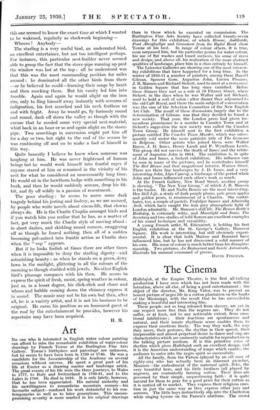Art
No one who is interested in English water colour painting can afford to miss the remarkable exhibition of water colour drawings by Francis Towne at the Burlington Fine Arts Gallery. Towne's birthplace and parentage are unknown, but he seems to have been born in 1739 or 1740. He was a candidate for the Associateship of the Academy on several occasions without success. He spent a great part of his life at Exeter as a drawing master and landscape artist. The great events of his life were the three journeys, to Wales in 1777, to Italy and Switzerland in 1780-81, and to the Lakes in 1786. He died in 1816. It is only lately, however, that he has been appreciated. His natural austerity and his unwillingness to romanticize mountain scenery—his favourite subject—rendered his work distasteful to his con- temporaries as well as to later generations. This uncom- promising severity is more marked in his original drawings
than in those which he executed on commission. The Burlington Fine Arts Society have collected twenty-seven drawings for this exhibition, of which Bison, Ambleside, Pont Aberglasllyn and Grasnnere from the Rydal Road show Towne at his best. In range of colour others, it is true, soon surpassed him, but his particular genius for water colour, his use of flat washes and toned surfaces, his sense of mass and design, and, above all, his realization of the more abstract qualities of landscape, place him in a class entirely by himself.
The Leicester Galleries are showing one of the most interest- ing exhibitions that have happened for a long time. In the winter of 1910-11 a number of painters, among them Harold Gilman, Spencer Gore, Augustus John, Lucien Pissarro, J. B. Manson and Richard Sickert, used to meet at a restaurant in Golden Square that has long since vanished. Before these dinners they met as a rule at 19 Fitzroy Street, where Sickert, in the days when he was Walter and not Richard, used to hold a sort of salon : after dinner they adjourned to the old Cafe Royal, and there the main subject of conversation was the sins of the Selection Committee of the New English Art Club. The result of these discussions, largely due to the determination of Gilman, was that they decided to found a new society. That year, the London press had given tre- mendous prominence to a murder in Camden Town and at Sickert's suggestion the new society was called the Camden Town Group. He himself sent to the first exhibition a picture entitled The Camden Town Murder, which was subse- quently sold under the more patriotic title of The Germanq in Belgium. Other artists who joined them were Walter Bayes, J. D. Innes, Henry Lamb and P. Wyndham Lewis. The group did not survive the death of Innes and the retire- ment of Augustus John in 1914. The exhibition is, in spite of John and Innes, a Sickert exhibition. His influence can be seen in many of the pictures, and he contributes himself The Red Blouse and that magnificent interior, Warren Street. There are three fine landscapes by J. D. limes, and a very interesting John, Llyn Cymeog, a landscape of the period when John and Innes influenced each other's work so much.
At the French Gallery, New Bond Street, another group is showing. " The New Year Group," of which J. B. Manson is the leader. He and Nadia Benois are the most interesting. Her Still Life, a study of dark purple plums, pale green apples and golden pears, is reminiscent of a Chardin. She contri- butes, too, a couple of pastels, Trafalgar Square and Admiralty Arch, which have caught the iron grey atmospheric light of London admirably. Mr. Manson's still life, The Brown Bottle's Birthday, is extremely witty, and Moonlight and Snow, The Secretary and two studies of wild flowers are excellent examples of his sound technique and versatility.
A young French artist, M. Etienneret, is holding his first English exhibition at the St. George's Gallery, Hanover Square. His work is interesting, but still obviously experi- mental. It is clear that both Matisse and Bonnard have influenced him, but he has not discovered a solid manner of his own. His sense of colour is much better than his draughts- manship. Two pictures, Au Restaurant and Soirée Automnale, illustrate his unusual command of greens.
DAVID FINCIIAM.






































 Previous page
Previous page